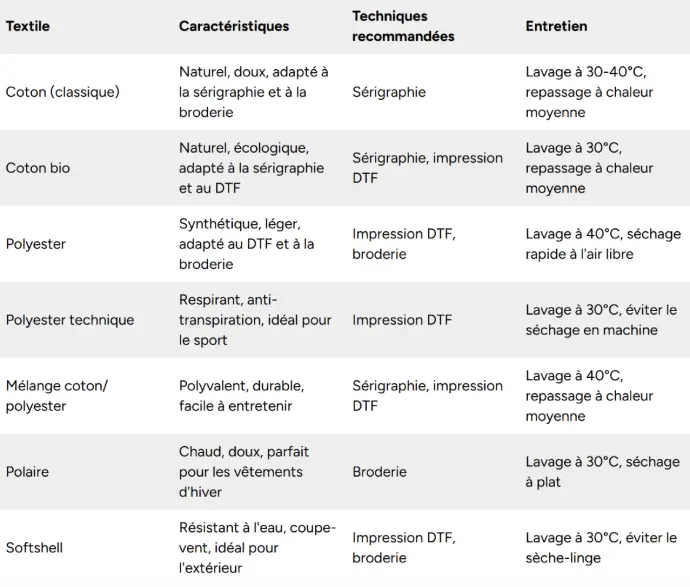Points clés
Un design inadapté
Couleurs mal gérées
Des fichiers non conformes
Des fichiers non conformes
Une technique d’impression mal choisie
Ignorer le BAT
Un entretien négligé
Manque de planification
La personnalisation textile est un outil puissant pour renforcer l’image de marque, marquer un événement ou fédérer une équipe. Mais attention : une impression textile personnalisée ne s’improvise pas.
Un mauvais choix de textile, un fichier mal préparé ou une mauvaise gestion des couleurs peuvent sérieusement compromettre le résultat.
Voici un guide complet des erreurs les plus courantes – et surtout, comment réussir une impression textile du premier coup.
Un design inadapté
Un bon visuel est la clé d’un t-shirt personnalisé de qualité. Trop souvent, des designs mal pensés nuisent à l’impact visuel.
- Polices trop fantaisistes : Elles peuvent sembler originales, mais deviennent vite illisibles. Pour personnaliser du textile, mieux vaut opter pour des polices sobres et lisibles de loin.
- Visuel surchargé : Trop de texte ou d’éléments détourne l’attention. Un message clair et concis est bien plus efficace.
- Mauvais ajustement de la taille du visuel : Un design trop grand gêne le port, un visuel trop petit passe inaperçu, notamment sur les tailles enfants.
💡 Astuce : réalisez une maquette ou demandez un visuel 3D pour évaluer lisibilité et équilibre.
🔗 À lire aussi : Logo minimaliste ou logo audacieux: que choisir pour votre marque ?
Couleurs mal gérées
L’un des pièges fréquents en personnalisation textile est la mauvaise gestion colorimétrique.
- RVB vs CMJN : Ce que vous voyez à l’écran (RVB) ne correspond pas toujours au rendu imprimé (CMJN). D’où des surprises à la livraison.
- Palette trop limitée ou mal choisie : Moins de couleurs ne veut pas dire moins d’impact… mais encore faut-il les choisir judicieusement.
💡 Astuce : utilisez un nuancier Pantone ou un simulateur CMJN pour valider les teintes.
🔗 À lire aussi : L'impact de la couleur dans la stratégie de marque : l'exemple de Heinz
Des fichiers non conformes
Un fichier mal préparé est l’erreur la plus évitable, mais aussi la plus fréquente.
- Résolution insuffisante : 300 DPI minimum pour un rendu net.
- Mauvais format : Le fichier vectoriel pour impression textile (.AI, .SVG, .PDF) est fortement recommandé.
- Fond mal géré : Transparent de préférence, sauf intention contraire.
💡 Astuce : faites valider vos fichiers par un professionnel ou testez-les avec un outil de prévisualisation.
🔗 À lire aussi : Impression textile : Comment envoyer des fichiers à la production comme un pro
Choix du textile inadapté
Le textile n’est pas qu’un support : c’est un choix stratégique.
- Broderie : Évitez les tissus trop fins.
- Sérigraphie & DTF : Idéals pour le coton ou le coton-polyester.
- Sublimation : Réservée aux textiles 100 % polyester blancs.
💡 Astuce : adaptez le textile à l’usage final (événementiel, sport, corporate) et à la technique utilisée.
🔗 En savoir plus : Les 5 erreurs à éviter dans la personnalisation de goodies
Une technique d’impression mal choisie
Chaque visuel, chaque textile, chaque besoin a sa méthode.
- DTG : idéal pour les détails et les petites séries.
- Sérigraphie : rentable pour de grandes quantités.
- Broderie : élégante, mais nécessite un tissu adapté.
- Sublimation : parfait sur polyester clair.
Ignorer le BAT
Valider un BAT (Bon à tirer) est une étape cruciale.
- Il centralise toutes les infos (taille, quantité, visuel, couleurs…).
- Son absence peut mener à des erreurs de production coûteuses.
💡 Astuce : relisez chaque détail du BAT et, si possible, demandez un échantillon.
Un entretien négligé
Même un vêtement personnalisé éco-responsable a besoin d’un minimum de soin.
- Lavage à 30°C, à l’envers
- Pas de sèche-linge
- Pas de fer directement sur le visuel

💡 Astuce : éduquez vos clients finaux sur l’entretien.
🔗 En savoir plus : Comment entretenir et prolonger la durée de vie de vos vêtements personnalisés ?
Manque de planification
Pas de budget, pas de planning = stress et surcoûts assurés.
- Prévoir un surplus pour les erreurs ou défauts
- Définir un rétroplanning clair
💡 Astuce : anticipez chaque étape – de la création à la livraison – pour une personnalisation textile fluide.
Conclusion
De la préparation des fichiers à la sélection du textile, en passant par le choix des couleurs et de la technique, chaque étape compte.
Que vous réalisiez un t-shirt personnalisé en Belgique pour un festival ou des vêtements éco responsables pour une entreprise, évitez les pièges classiques grâce à ces conseils.



Les erreurs les plus fréquentes en impression textile (et comment les éviter)